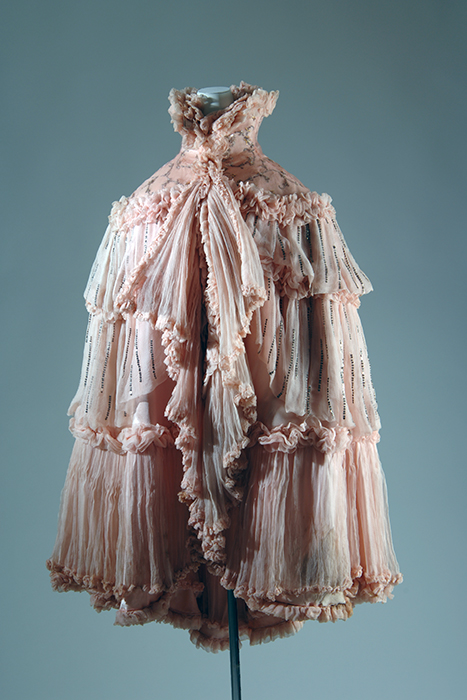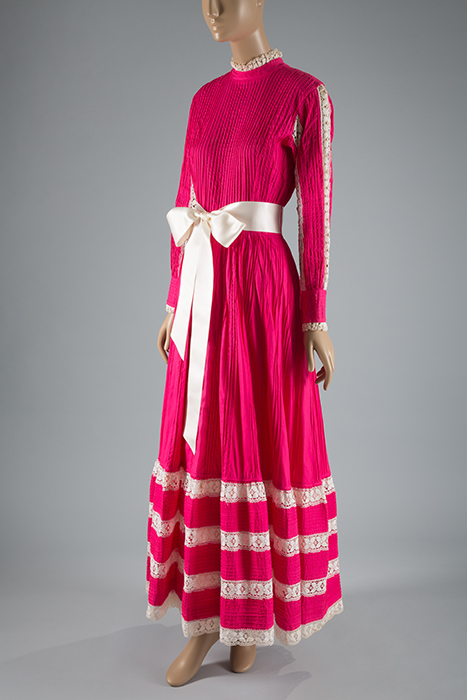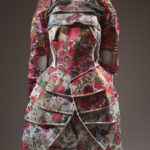The Feminization of Color
-
Image InfoClose
Feminization of Color Installation Image
-
Image InfoClose
Dress
The feminization of color was a significant development in nineteenth-century western fashion. As Euro-American men increasingly wore dark, sober colors, such as black and navy blue, they left bright and pastel shades to women.
Two-piece silk taffeta, circa 1857, Museum purchase. P92.40.1
-
Image InfoClose
Robert Evening Gown
By 1910, however, bright “exotic” colors began to come into fashion, pioneered by avant-garde designers, such as Paul Poiret, who mocked the turn-of-the-century enthusiasm for pale pastel shades with names like “Nymph’s Thigh.”
Silk velvet, metallic lace, and silk crepe chiffon, 1912-1914, Museum purchase. 2016.8.1
-
Image InfoClose
Paquin Evening Cape
The development of chemical dyes in the mid-nineteenth century resulted in very bright colors. As inexpensive bright pink became popular, the elite developed a taste for very pale pastels.
Silk chiffon, 1897, Museum purchase. P83.19.7
Think Pink
-
Image InfoClose
Think Pink Installation View
-
Image InfoClose
Charles James “Tree” Dress
Young, beautiful, fertile women have often been compared to flowers, as with Wagner’s Flower Maidens. One implication is that a woman’s beauty, like that of a flower, lasts only a short time.
Silk taffeta, silk satin, and velvet, 1955, Museum purchase. P87.31.11
-
Image InfoClose
The dominant discourse on pink in the postwar decades emphasized its connection with an essentialist idea of femininity, where biology was destiny. Of course, pink lingerie has a much longer history.
Poirette Bra
Nylon lace and stretch satin, 1949, Gift of Bestform Inc. 2000.89.15Christian Dior Petticoat
Nylon net, horsehair net, and silk taffeta, 1951, Gift of Despina Messinesi. 75.86.5B -
Image InfoClose
Evening Dress
In her important book, As Long As It’s Pink: The Sexual Politics of Taste, Penny Sparke describes how and why pink became so popular after World War II, when it represented “the emphasis on distinctive gendering that underpinned 1950s society.”
Silk taffeta, circa 1954, Gift of Virginia Pope. 75.149.1
60s and 70s
-
Image InfoClose
Yves Saint Laurent for Christian Dior Cocktail Dress
We tend to identify pink with the 1950s (the era of “Think pink!”), but American Vogue (1963) declared the 1960s “the new pink decade.” Diana Vreeland “wasn’t afraid to dedicate 20 pages to pink,” recalled her colleague Polly Mellen. Not only would there be “pink lipstick and nail polish all over the ad pages,” soon “you were seeing pink on every street corner.”
Silk faille, 1960, Museum purchase. 2017.80.1
-
Image InfoClose
Yves Saint Laurent Evening Dress
The 1970s was not a pink decade for women’s fashion, although some designers continued to use the color. Yves Saint Laurent, for example, always loved pink, and admired Schiaparelli because “she gave pink the nerve of red. A pink that went on to devour everything in its path… Shocking pink!”
Satin, circa 1978, Gift of Mildred S. Hilson. 82.99.1
-
Image InfoClose
André Courrèges Dress
Although André Courrèges was best known for his futuristic white clothes, he often utilized pale pinks. L’Officiel de la couture advised readers to “dress in young girl pink that you love when you are 20 years old, and that you still want to wear as long as your face permits you to do so.”
Couture appliqued silk organza with paillettes, spring/summer 1967, Gift of Sylvia Slifka. 86.49.7
-
Image InfoClose
André Courrèges Coat
Wool and acrylic, 1967, Gift of Mrs. Phillip Schwartz. 81.132.2
Power Pink
-
Image InfoClose
Power Pink Installation View
-
Image InfoClose
Claude Montana Skirt Suit
Pink became very fashionable again in the 1980s. Although some have interpreted the revival of pink as part of a “backlash” against women, others perceive it in terms of third generation feminism, with young women rejecting the idea that they had to look like imitation men. Certainly, a bright pink, skirted suit seems to convey the image of a powerful woman.
Silk and wool, 1980s, Museum purchase. 2017.64.1
-
Image InfoClose
Helmut Lang Ensemble
In retrospect, Helmut Lang was one of the most influential designers of the 1990s, with his edgy but elegant clothes. In an article for Vogue, Sarah Mower recalls how Lang’s designs were a “coded disguise” for “the cool of both sexes.” A dress like this one implicitly asked: “Who recognized the sly flashes of acid-house pink? They didn’t. We did.”
Pink polyester chiffon and white cotton jersey, spring 1999, Gift of HL – art. 2009.32.6
-
Image InfoClose
Chanel Ensemble
Karl Lagerfeld allegedly once said, “Think pink! But don’t wear it.” In reality, of course, he has often designed looks such as this pale pink suit, which updated Mademoiselle’s pink suits of the 1960s, and attracted great editorial attention in 1994.
Cotton, wool, and synthetic blend tweed suit and cotton T-shirt, spring 1994, Gift of Chanel Inc. 94.80.1
A World of Pink
-
Image InfoClose
A World of Pink Installation View
-
Image InfoClose
Baby, the Stars Shine Bright Ensemble
Pink has long played an important role in Japanese culture. But pink’s greatest impact on fashion came during the late twentieth century, with the rise of Japanese girl culture. This is not the pink of cherry blossoms, but rather a “cute” pink drawing on ideas of childish femininity.
Cotton and synthetic, 2009, Museum purchase. 2010.50.2
-
Image InfoClose
Lila Bath Mexican Wedding Dress
Designed by Mexico-based designer Lila Bath, this dress was originally resort wear. The maxi style featuring tucked cotton and lace was known in the USA as a Mexican wedding dress. In the United States, Mexican pink epitomizes traditional Mexico, while south of the border the color is often used to express modernity.
Cotton and lace, 1972, Gift of Tanya Melendez. 2017.54.1
-
Image InfoClose
Mimi Plange Dress
“This pink dress was inspired by African scarification,” says Ghana-born designer, Mimi Plange. “We chose leather as the perfect ’skin’ to mimic the intricate patterns of scarification. Fresh scars are usually pink or red, and as time passes, they begin to fade. This light ‘fleshy’ pink was chosen to represent fresh open wounds, and the beauty they represent in traditional African scarification.”
Leather, spring 2013, Gift of Mimi Plange. 2016.49.1
-
Image InfoClose
Cam’ron Sweatshirt
In 2002, Harlem rapper, Cam’ron wore pink mink to New York Fashion Week. Although he was not the first male rapper to wear pink (Big Boi wore pink to the 2001 MTV Music Video Awards), Cam’ron is widely credited with getting men into pink. “People showed me so much love for the pink mink I wore,” said Cam’ron, “I had to go out to Pantone and create my own color, which is called Killa pink.”
Cotton blend, circa 2003, Anonymous donor. 2018.4.1
-
Image InfoClose
Puma x Fenty Ensemble
Rihanna has often worn pink, and she collaborated with Puma to create an entire Fenty Puma collection — all in pink.
Polyester jacket and synthetic satin and rubber sneakers, spring 2017, Gift of Puma. 2017.29.1, 2017.29.2
Punk Pink
-
Image InfoClose
Punk Pink Installation View
-
Image InfoClose
Comme des Garçons Ensemble
Rei Kawakubo’s famous “18th-Century Punk” collection utilized the shapes and colors of pre-Revolutionary French fashion to convey a message of transgressive female power. The wide paniers on the 1750 dress are here transposed into broad shoulders and wide, ruffled sleeves.
Pleather, faux fur, rubber, and synthetic, fall 2016, Museum purchase. 2017.52.1
-
Image InfoClose
Comme des Garçons Ensemble
Pink can be fierce and feminist, punk and powerful — as Kawakubo’s woman warrior in floral body armor demonstrates. This look comes from the Comme des Garçons “18th-Century Punk” collection.
Polyester, acetate, nylon, and cotton, fall 2016, Museum purchase. 2016.6.1
Pink Today
-
Image InfoClose
Pink Today Installation View
-
Image InfoClose
Céline Dress
Phoebe Philo’s work for Céline has been extraordinarily popular with fashion professionals for whom it represented the intelligent woman’s style of dress. Her draped dress in “Lipstick Fluid” jersey is therefore a sign that pink has become accepted as a grown-up color.
Synthetic knit, spring 2017, Gift of Céline. 2017.19.1
-
Image InfoClose
Raf Simons for Jil Sander Man’s suit
Raf Simons’ work for Jil Sander included important pink designs for both men and women. Now at Calvin Klein, Simons continues to push fashion forward.
Polyester, cotton, nylon, spandex, spring 2011, museum purchase. 2018.19.1
-
Image InfoClose
Gucci Dress
Gucci’s Alessandro Michele was an early exponent of pink for both men and women. Pink is one of his favorite colors, and he has said that he enjoys finding different shades of pink in antique shops. Pink also fits the deliberate artificiality and maximalism of his aesthetic.
Silk organza, spring 2016, Gift of Gucci. 2016.93.1
The Exposed Color
-
Image InfoClose
The Exposed Color Installation View
-
Image InfoClose
Corset
Pink has long been associated with the second skin of lingerie and other types of seductive apparel. Although black is now the dominant fetish color, the fetishization of pink has not disappeared, as witnessed by the notoriety of the pink corset worn by Madonna.
Silk satin, 1880s, Museum purchase. 99.79.2
-
Image InfoClose
Thierry Mugler Evening Gown
By placing a pale pink sheath under black lace, Thierry Mugler reinforces pink satin’s association with the exposure of (Caucasian) skin. Compare this dress with John Galliano’s evening dress.
Satin, Chantilly lace, and velvet, 1994, Museum purchase. 2016.114.2
-
Image InfoClose
Jean Paul Gaultier Corset Dress
Obsessed with corsets since childhood, Jean Paul Gaultier was instrumental in creating the idea of underwear-as-outerwear.
Cotton, nylon, and satin, circa 1987, Museum purchase. 98.98.1
Pompadour Pink
-
Image InfoClose
Robe à la française
Before the French Revolution, aristocratic women and men wore similarly colorful and decorative fashions. Although men were, in reality, far more powerful than women, individual elite women seemed very powerful. Later generations would ensure that women were kept in a clearly subordinate position.
Patterned silk robe à la française, 1750s, Museum purchase. 2017.46.1
-
Image InfoClose
Man’s banyan
Although humans in every culture are biologically equipped to see pink things (such as flowers), many languages do not have a word for “pink” — or only developed one after many centuries. “Rose,” as an adjective of color, only entered the French language in the eighteenth century, about the same time “pink” was first used as a color term in English.
Metallic silk brocade, 1748-1760, Museum purchase. 2010.98.2

















































































